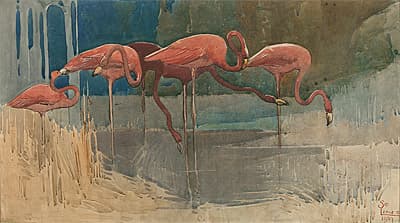Sydney
LONG
Australia
1871
–
London
1955
England, Europe 1910-21; Australia 1921- 22; England 1922-25; Australia 1925-52; England from 1952
31.0 (h) x 55.0 (w) cm
signed and dated ‘SID LONG/ 1907’ lower right private collection
Long’s preoccupation with flamingoes is likely to have stemmed from their innate decorative qualities, their long sinuous necks, as well as from their exotic connotations. Ancient Egyptians revered the flamingo as a living representation of the sun god Ra. Early Christians thought the flamingo was the basis of the legend of the Phoenix, a red bird who rose from the ashes.
In this 1907 watercolour, Long modified the colour of the flamingoes, from that in his earlier images, to a softer red and emphasised the decorative Art Nouveau trees behind them.
Flamingoes are sociable birds, and live in colonies. They are a type of wading bird, often found standing on one leg, the other tucked beneath the body. It has been suggested that they have the ability for just one half of their body to go to sleep and, when that half is rested, they swap legs and let the other half sleep. Another theory is that by standing on one leg they are able to conserve body heat, which is an advantage given they spend a large amount of time wading in water. They originally came from South America, Africa, Asia and Europe. Flamingoes are an important tourist attraction in places such as the Camargue in France and Lake Nakuru in Kenya.
Young flamingoes have grey plumage, but adults vary from light pink to dark red. The colour comes from the food flamingoes eat, such as algae and small shrimps, which contain beta carotenes and this turns their feathers pink. A well-fed flamingo is said to be more brightly coloured, and captive flamingoes often turn pink because they are not fed sufficient beta carotene.
This painting was possibly the watercolour of flamingoes that was first shown in the 1907 ‘Society of Artists exhibition’ (242).
Long’s preoccupation with flamingoes is likely to have stemmed from their innate decorative qualities, their long sinuous necks, as well as from their exotic connotations. Ancient Egyptians revered the flamingo as a living representation of the sun god Ra. Early Christians thought the flamingo was the basis of the legend of the Phoenix, a red bird who rose from the ashes.
In this 1907 watercolour, Long modified the colour of the flamingoes, from that in his earlier images, to a softer red and emphasised the decorative Art Nouveau trees behind them.
Flamingoes are sociable birds, and live in colonies. They are a type of wading bird, often found standing on one leg, the other tucked beneath the body. It has been suggested that they have the ability for just one half of their body to go to sleep and, when that half is rested, they swap legs and let the other half sleep. Another theory is that by standing on one leg they are able to conserve body heat, which is an advantage given they spend a large amount of time wading in water. They originally came from South America, Africa, Asia and Europe. Flamingoes are an important tourist attraction in places such as the Camargue in France and Lake Nakuru in Kenya.
Young flamingoes have grey plumage, but adults vary from light pink to dark red. The colour comes from the food flamingoes eat, such as algae and small shrimps, which contain beta carotenes and this turns their feathers pink. A well-fed flamingo is said to be more brightly coloured, and captive flamingoes often turn pink because they are not fed sufficient beta carotene.
This painting was possibly the watercolour of flamingoes that was first shown in the 1907 ‘Society of Artists exhibition’ (242).
Long’s preoccupation with flamingoes is likely to have stemmed from their innate decorative qualities, their long sinuous necks, as well as from their exotic connotations. Ancient Egyptians revered the flamingo as a living representation of the sun god Ra. Early Christians thought the flamingo was the basis of the legend of the Phoenix, a red bird who rose from the ashes.
In this 1907 watercolour, Long modified the colour of the flamingoes, from that in his earlier images, to a softer red and emphasised the decorative Art Nouveau trees behind them.
Flamingoes are sociable birds, and live in colonies. They are a type of wading bird, often found standing on one leg, the other tucked beneath the body. It has been suggested that they have the ability for just one half of their body to go to sleep and, when that half is rested, they swap legs and let the other half sleep. Another theory is that by standing on one leg they are able to conserve body heat, which is an advantage given they spend a large amount of time wading in water. They originally came from South America, Africa, Asia and Europe. Flamingoes are an important tourist attraction in places such as the Camargue in France and Lake Nakuru in Kenya.
Young flamingoes have grey plumage, but adults vary from light pink to dark red. The colour comes from the food flamingoes eat, such as algae and small shrimps, which contain beta carotenes and this turns their feathers pink. A well-fed flamingo is said to be more brightly coloured, and captive flamingoes often turn pink because they are not fed sufficient beta carotene.
This painting was possibly the watercolour of flamingoes that was first shown in the 1907 ‘Society of Artists exhibition’ (242).

